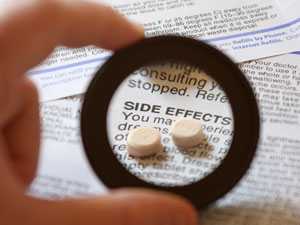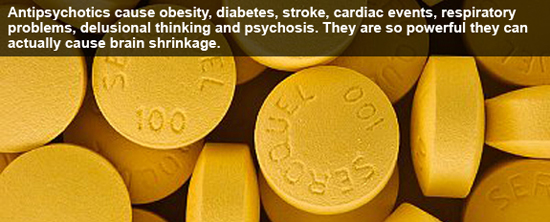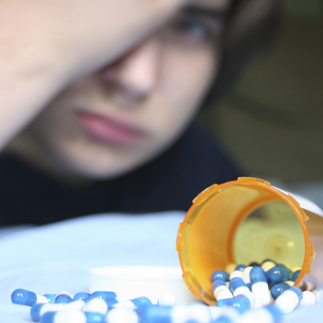The New American
February 10, 2015
By Raven Clabough
A recent MedicalXpress.com article highlights startling research on the serious side effects of antipsychotic medications. In addition, many of the medications are failing to relieve the symptoms for which they were prescribed.
Researchers at Australia’s Murdoch University in Perth and the University of Queensland found that the side effects of the antipsychotics include Parkinsonism, restlessness, involuntary movements, weight gain, insomnia, sexual dysfunction, constipation, dry mouth. and dizziness. The most prevalant side effect is extreme fatigue, which leaves many in a “zombie state,” they report.
Murdoch University Professor Paul Morrison commented,
People using antipsychotic medications experience adverse side-effects that reach into their physical, social and emotional lives, and cause a level of fear and suffering that is difficult for anyone else to fully comprehend.

Side effects of the antipsychotics include Parkinsonism, restlessness, involuntary movements, weight gain, insomnia, sexual dysfunction, constipation, dry mouth. and dizziness.
The proportion that experiences a disturbing side-effect has been estimated at between 50 and 70 per cent, and participants in our study reported on average between six and seven medication side-effects.
Even worse, antipsychotic medications also provoke side effects that are strangely similar to the symptoms that the users are attempting to combat, including feelings of hopelessness.
“The issue here is the extent to which people with a mental illness have been conditioned into accepting the disabling effects of psychotropic medications without protest,” Professor Morrison explains, adding,
The ability of mental health staff to forestall protest arises from the guilt communities thrust upon the sufferer. Without this guilt and shame, would mental health consumers and their loved ones be so ready to accept that a life of zombie-like consciousness and physical discomfort is preferable to hearing voices, or would they be demanding more intensive efforts to develop “cleaner” medications?
Based on the findings, researchers suggest creating a standardized rating scale that would assess and monitor the side effects of these medications and encourage better communication between patients are their doctors.
According to the Citizens Commission on Human Rights (CCHR) — a mental health watchdog committed to eradicating “abuses committed under the guise of mental health” — the dangers associated with antipsychotic medications cannot be ignored. The group’s website reads,
 There have been 72 warnings from eight countries (United States, United Kingdom, Canada, Japan, Australia, New Zealand, Ireland and South Africa) warning that antipsychotic drugs cause harmful side effects. These include the following (note that some warnings cite more than one side effect, so the list below may not be equal to the total number of warnings):
There have been 72 warnings from eight countries (United States, United Kingdom, Canada, Japan, Australia, New Zealand, Ireland and South Africa) warning that antipsychotic drugs cause harmful side effects. These include the following (note that some warnings cite more than one side effect, so the list below may not be equal to the total number of warnings):
17 warnings on antipsychotics causing heart problems; 15 warnings on antipsychotics causing death/sudden death; 9 warnings on antipsychotics causing weight gain; 8 warnings on antipsychotics causing involuntary movements or movement disorders; 7 warnings on antipsychotics causing strokes; 7 warnings on antipsychotics causing withdrawal symptoms; 6 warnings on antipsychotics causing convulsions, seizures or tremors; 5 warnings on antipsychotics causing diabetes; 5 warnings on antipsychotics causing birth defects; 4 warnings on antipsychotics causing agitation;1 warning on antipsychotics causing mania and psychosis; and 1 warning on antipsychotics causing sexual dysfunction.
Sadly, despite the side effects connected to these antipsychotic drugs, the number of children taking them continues to rise at alarming rates. Research shows that those numbers have nearly tripled over the last decade, not simply because there is a sudden increase in the number of children diagnosed with schizophrenia or any other serious mental illness, but because more doctors are prescribing drugs to treat behavioral problems.
Consumer Reports writes,
Doctors are prescribing antipsychotics even though there’s minimal evidence that the drugs help kids for approved uses, much less the unapproved ones, such as behavioral problems. And to make matters worse, the little research there is suggests the drugs can cause troubling side effects, including weight gain, high cholesterol, and an increased risk of type-2 diabetes.
Some believe that the increase in these prescriptions results from parents looking to find an easy solution to their children’s behavioral problems.
“There’s a societal trend to look for the quick fix, the magic bullet that will correct disruptive behaviors,” said David Rubin, M.D., associate professor of pediatrics at the Perelman School of Medicine at the University of Pennsylvania in Philadelphia. “But for those looking for a quick solution to escalating behaviors at home, the hard truth is there is unlikely to be a quick fix.”
Consumer Reports also notes the increase in the prescribing of antipsychotics can be attributed to several other factors, including aggressive drug marketing and a lack of access to quality healthcare.
Antipsychotics have become huge moneymakers for the drug industry. In 2003, annual U.S. sales of the drugs were estimated at $2.8 billion; by 2011, that number had risen to $18.2 billion. That huge growth was driven in part by one company — Janssen Pharmaceuticals — and its aggressive promotion of off-label uses in children and elderly patients, relying on marketing tactics that according to the federal government, crossed legal and ethical lines.
 Further, data from the Centers for Disease Control revealed that there continues to be a significant increase in the number of school-age children on psychiatric medications to treat emotional or behavioral problems. One health study shows that 7.5 percent of children between the ages of six and 17 are on psych meds based on data collected from interviews between 2011 and 2012 with parents of over 17,000 children.
Further, data from the Centers for Disease Control revealed that there continues to be a significant increase in the number of school-age children on psychiatric medications to treat emotional or behavioral problems. One health study shows that 7.5 percent of children between the ages of six and 17 are on psych meds based on data collected from interviews between 2011 and 2012 with parents of over 17,000 children.
“Over the past two decades, the use of medication to treat mental health problems has increased substantially among all school-aged children and in most subgroups of children,” the report’s authors explained.
Unfortunately, the survey did not identify which diagnoses were being treated by the medications, but estimates indicate that a majority of the drugs are to treat ADHD symptoms, a point that critics are likely to seize upon. As noted by the UPI, “The study may lend credence to critics who say America’s children are over-diagnosed with ADHD — and subsequently over-prescribed and over-medicated.”
According to the American Psychiatric Association, five percent of American children have ADHD, but studies reveal more than 11 percent of American children are diagnosed with the condition.
What may be more alarming is that there is increasing evidence that ADHD may not be the epidemic that some are claiming, and in fact, may not even be an actual condition.
Dr. Richard Saul, who has been practicing behavioral neurology for 50 years, and is the author of the new book ADHD Does Not Exist, writes in a March 2014 Time piece,
The fifth edition of the DSM [Diagnostic and Statistical Manual of Mental Disorders] only requires one to exhibit five of 18 possible symptoms to qualify for an ADHD diagnosis. If you haven’t seen the list, look it up. It will probably bother you. How many of us can claim that we have difficulty with organization or a tendency to lose things; that we are frequently forgetful or distracted or fail to pay close attention to details? Under these subjective criteria, the entire U.S. population could potentially qualify.
Saul’s analysis confirms what critics have been saying regarding the growth in the rate of mental illness issues: that it may in fact be the result of expanded medical terms and definitions.
Slate.com warned of such a thing in April 2013:
Beware the DSM-5, the soon-to-be-released fifth edition of the “psychiatric bible,” the Diagnostic and Statistical Manual. The odds will probably be greater than 50 percent, according to the new manual, that you’ll have a mental disorder in your lifetime.
Although fewer than 6 percent of American adults will have a severe mental illness in a given year, according to a 2005 study, many more — more than a quarter each year — will have some diagnosable mental disorder. That’s a lot of people. Almost 50 percent of Americans (46.4 percent to be exact) will have a diagnosable mental illness in their lifetimes, based on the previous edition, the DSM-IV. And the new manual will likely make it even “easier” to get a diagnosis.
The expanded definitions have resulted in significant increases in diagnoses of mental disorders, particularly ADHD. Dr. Saul writes, “The New York Times reported that from 2008 to 2012 the number of adults taking medications for ADHD increased by 53% and that among young American adults, it nearly doubled.”
 According to CCHRINT, there is abundant evidence proving a connection between psychotropic medications and violent crimes, and government officials are well aware of the connection.
According to CCHRINT, there is abundant evidence proving a connection between psychotropic medications and violent crimes, and government officials are well aware of the connection.
“Between 2004 and 2011, there have been over 11,000 reports to the U.S. FDA’s MedWatch system of psychiatric drug side effects related to violence,” says CCHRINT, including 300 homicides.
Groups such as CCHR are committed to informing the public of the documented risks of psychiatric drugs, and has created a guide to documented psychiatric drug side effects, taking the official FDA adverse reaction reports (MedWatch data), international drug regulatory agency warnings and studies, and summarizing the often complex information into an easy, user-friendly format for consumers, researchers and policy makers.
Read entire article here: http://www.thenewamerican.com/usnews/item/20090-research-antipsychotic-meds-cause-hopelessness-zombie-like-state



SHARE YOUR STORY/COMMENT